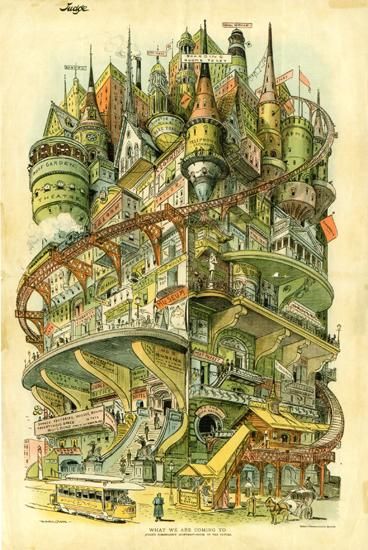Building Expectations
How do people decide what does or doesn’t look futuristic?
/https://tf-cmsv2-smithsonianmag-media.s3.amazonaws.com/filer/20111018090014building-expectation-sm-470x251.jpg)
Brown University has an exhibit running through November 6 called “Building Expectation: Past and Present Visions of the Architectural Future.” The exhibit catalog has some fascinating write ups: one on King Camp Gillette (yes, the razor guy) and his vision for a utopian community near Niagara Falls; another about postcards from the turn of the 20th century that envisioned cities of the future; and a great piece on architect Hugh Ferriss and how his stark 1920s visions for New York influenced popular culture.
The objective of the exhibition—which spans from the 19th century to the present day—is to ask a number of basic but important questions:
What do people stand to gain from designing “futures”? How do people, individually and collectively, decide what does and does not look futuristic, what is and is not permitted to inhabit “the future”? Is it merely a process of extrapolation, in which we attempt to imagine the fulfillment of trends and patterns that are gaining power in the present—or is something more subjective, more arbitrary, more rhetorical, and/or more creative taking place?
Below is one of the featured illustrations. Drawn for the February 16, 1895 issue of Judge magazine, the architectural future is used as a humorous foil for the social and political concerns of the era.

“In this satirical take on the trajectory of urban evolution, Hamilton pokes some rather pointed fun at the tendency of capitalist industry to relentlessly intensify the scale of real-estate development, in this nominally residential building are found not only shops, living space, and a steam-powered mass transport system, but also religious institutions and the houses of government —the public realm has been totally absorbed by the monolithic power of the private.”
The exhibit is free and open to the public at the David Winton Bell Gallery, inside the List Art Center, Monday through Friday from 11am until 4pm and on Saturday and Sunday from 1 until 4pm.
/https://tf-cmsv2-smithsonianmag-media.s3.amazonaws.com/accounts/headshot/matt-novak-240.jpg)
/https://tf-cmsv2-smithsonianmag-media.s3.amazonaws.com/accounts/headshot/matt-novak-240.jpg)